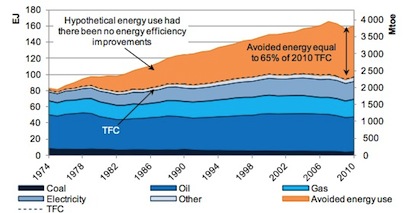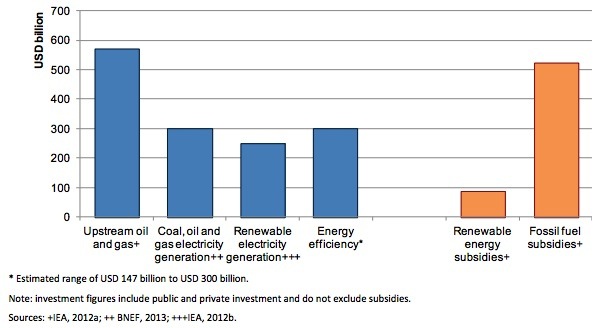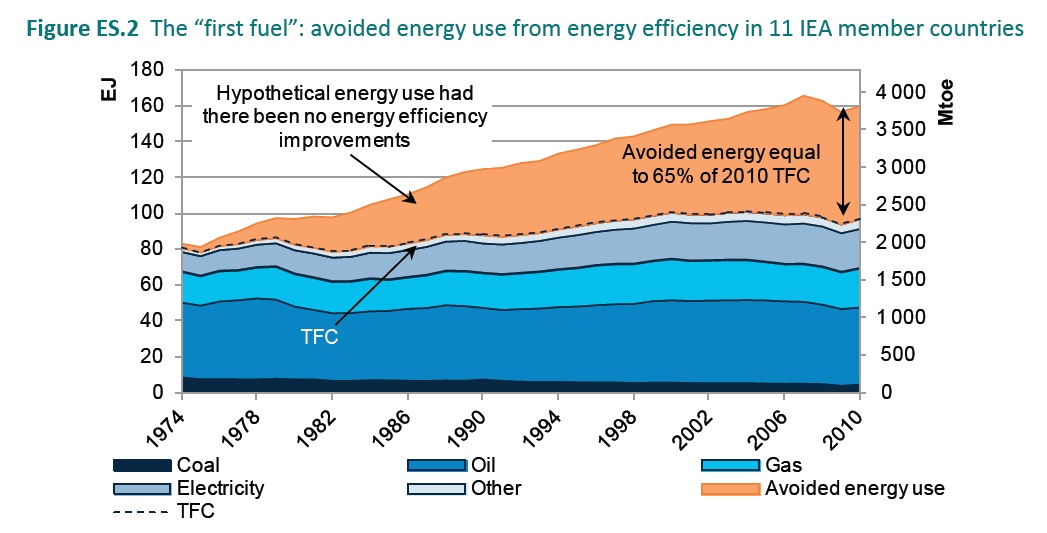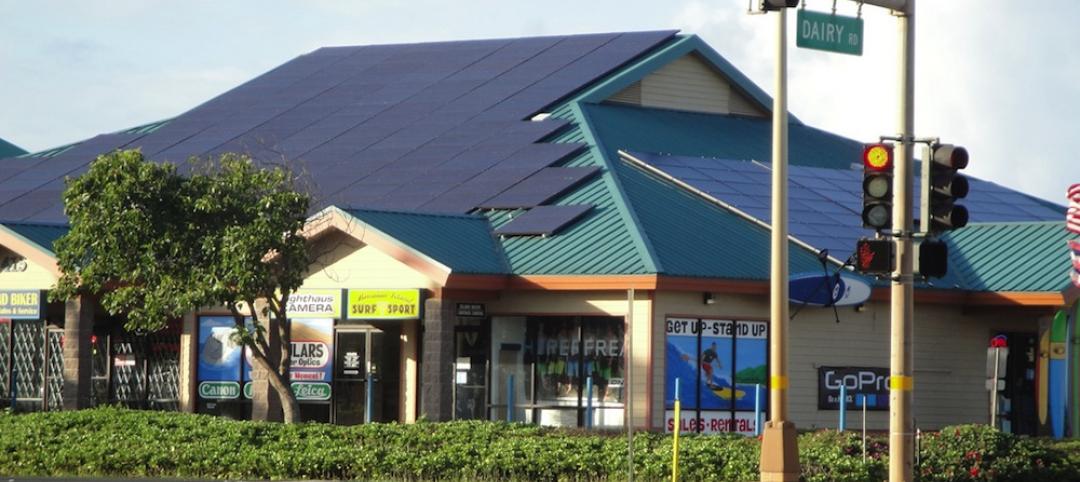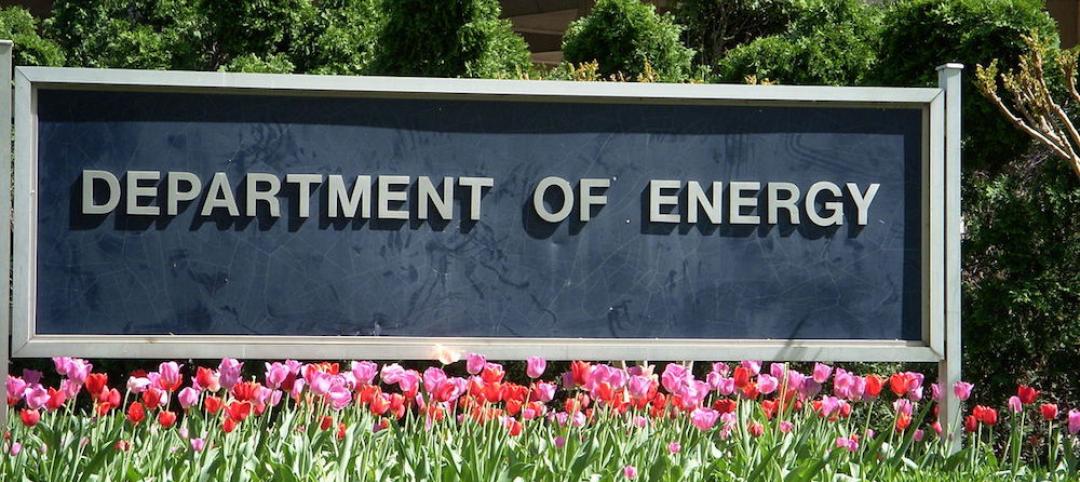Avoided energy use attributable to energy-efficiency investments undertaken since 1974 has resulted in a contribution outstripping the annual consumption of oil, natural gas, electricity, and coal, according to a report by the International Energy Agency, a global NGO.
An analysis of energy consumption in 11 IEA member countries indicates that avoided annual energy use in 2010 was 63 exajoules, or the equivalent of 1.52 billion tonnes of oil. This avoided energy use was larger than the countries' consumption of oil (43 EJ), electricity and natural gas (22 EJ each), and coal (less than 10 EJ).
The equivalent cost of oil for 63 exajoules of energy would have been about $420 billionUS. (Countries included in the analysis were Australia, Denmark, Finland, France, Germany, Italy, Japan, the Netherlands, Sweden, the United Kingdom, and the United States.)
Investments in energy efficiency measures have also reduced the amount of energy needed to produce each unit of gross domestic product, according to the report. As of 2011, total investment in energy efficiency resembled the supply-side investment in renewable or fossil-fuel electricity generation.
However, fossil-fuel development benefits from a much higher level of government subsidies than energy-efficiency measures. In 2011, fossil fuels were the recipient of more than $500 billion in global subsidies, compared with less than $100 billion in subsidies for renewable energy (below).
Table: Global investments and subsidy in selected areas of the energy system, 2011. Source: IEA.
The IEA indicates that governmental policy interventions are the most significant stimulant for energy-efficiency investments. High energy prices are also triggering expansion of the energy-efficiency market, though subsidies for fossil fuels continue to artifically reduce the price consumers pay for energy.
Performance improvements in buildings are targeted as an important factor in continued reduction of global energy use. The report discusses notable investments in this area by Germany, New Zealand, France, and Mexico, mainly involving residential construction.
For the medium term, the IEA predicts that private investment enabled by favorable government policies, rather than direct public investment, will continue to represent the greatest source of funding for energy-efficiency projects.
Influential changes in codes and standards in Canada, France, Germany, South Korea, China, Japan, and the U.K. should drive growth in the energy-efficiency sector. For the U.S., new standards for appliances and continued growth in the ESCO industry may be significant.
Continued savings should be possible during the next decade, according to the agency, perhaps amounting to about 7% of 2010's total global consumption--or greater than the combined current energy use of Australia, Japan, Korea, and New Zealand.
Click here for the full report.
The editors thank Grumman / Butkus Associates for bringing this report to our attention.
Related Stories
Sports and Recreational Facilities | Apr 17, 2016
An expanded and renovated complex brings together U. of Colorado’s sports programs
This two-year project enhances the experiences of athletes and fans alike.
Building Technology | Apr 11, 2016
A nascent commercial wireless sensor market is poised to ascend in the next decade
Europe and Asia will propel that growth, according to a new report from Navigant.
Multifamily Housing | Mar 10, 2016
Access and energy control app clicks with student housing developers and managers
Ease of installation is one of StratIS’s selling features.
BIM and Information Technology | Mar 2, 2016
Thanks to MIT researchers, Boston now has its very own citywide building energy model
The most detailed model ever for a city this size will help Boston meet its long-term energy use goals.
Energy Efficiency | Feb 23, 2016
Economists, energy efficiency practitioners need to work together for better cost/benefit studies
Flawed energy efficiency research yields misleading, confusing results.
Green | Feb 18, 2016
Best laid plans: Masdar City’s dreams of being the first net-zero city may have disappeared
The $22 billion experiment, to this point, has produced less than stellar results.
Green | Feb 1, 2016
Supreme Court ruling on demand response expected to benefit smart grid
Ruling allows PV owners and other small energy generators to continue to be paid wholesale rates for power they generate.
Codes and Standards | Jan 22, 2016
State Savings Calculator analyzes savings associated with energy codes
The calculator breaks down the cost-effectiveness of energy codes on a state-by-state basis.
Green | Nov 17, 2015
DOE launches new data collaborative to help cities and states boost building efficiency
The SEED Standard will help manage, standardize, share performance data.
Energy Efficiency | Nov 16, 2015
Amazon will heat its new Seattle campus with waste heat from next-door data centers
Up to 4 million kilowatt-hours of energy will be saved each year.


